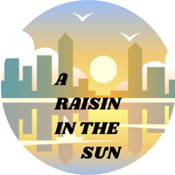
Overview
Synopsis
A Raisin in the Sun is a play about dreams; what it means to dream big, to lose faith in your dreams, and to discover new dreams. It is also a story about family. We meet the Younger family the day before they are getting a $10,000 insurance check from the death of the father, Walter Younger. We watch as different members of the family have different ideas of how to use the money: Mama wants to buy a house with a little garden in the back, Walter Lee Younger (their son) wants to invest in a liquor store, Ruth (Walter Lee’s wife) wants a house with some space and a nice kitchen, and Beneatha (Walter Lee’s sister) wants to go to medical school. Tensions increase as each member of the family tries to get their own way, eventually threatening to break apart their foundation completely. The stakes continue to climb as questions about identity, class, value, race, and love become forefront issues, and outsiders to the family make it impossible to forget the world that the Younger family cannot seem to escape.
Show Information
Context
Harlem
by Langston Hughes
What happens to a dream deferred?
Does it dry up
Like a raisin in the sun?
Or fester like a sore--
And then run?
Does it stink like rotten meat
Or crust and sugar over--
Like a syrupy sweet?
Maybe it just sags
Like a heavy load.
Or does it explode?
Lorraine Hansberry found her inspiration to write A Raisin in the Sun from the Langston Hughes poem Harlem as well as from her own life experiences growing up in a hostile, racially charged environment. _A
to read the context for A Raisin in the Sun and to unlock other amazing theatre resources!Plot
ACT I
Scene 1
The lights come up as the alarm clock begins to ring. Travis (Walter Lee and Ruth’s 10 year old son) is asleep on the living room couch, the only bedroom he has. Ruth enters sleepily and tries to wake him up. After her third attempt, Travis gets up groggily and goes into the bathroom which is in the hallway and is shared by the other tenants on the floor (unfortunately including the Johnsons down the hall). Ruth begins to make breakfast, soon realizing that Walter Lee is
to read the plot for A Raisin in the Sun and to unlock other amazing theatre resources!Characters
| Name | Part Size | Gender | Vocal Part |
|---|---|---|---|
|
Lead |
Female |
Non-singer |
|
|
Lead |
Female |
Non-singer |
|
|
Lead |
Male |
Non-singer |
|
|
Lead |
Female |
Non-singer |
|
|
Supporting |
Male |
Non-singer |
|
|
Supporting |
Male |
Spoken |
|
|
Supporting |
Male |
Spoken |
|
|
Featured |
Male |
Spoken |
|
|
Featured |
Male |
Spoken |
|
|
Featured |
Female |
Spoken |
|
|
Ensemble |
Male |
|
Songs
A song with an asterisk (*) before the title indicates a dance number; a character listed in a song with an asterisk (*) by the character's name indicates that the character exclusively serves as a dancer in this song, which is sung by other characters.
Monologues
Scenes
Key Terms
A dramatic theme involving cultural adaptation or loss of identity, explored in works about immigration and heritage.
A historical movement of African Americans northward that shaped cultural and theatrical narratives in the 20th century.
A cultural movement of the 1920s and 30s celebrated in theatre for its artistic contributions and Black identity expression.
A cultural movement during the Harlem Renaissance promoting African-American arts, identity, and political empowerment.
A Titan from Greek mythology whose defiance of Zeus symbolizes rebellion and human suffering in classical and modern drama.
The inclusion of racially diverse casts and themes, reflecting social progress and realism in theatre.
A metaphor or literal device used in plays to symbolize entrapment, commonly seen in psychological or symbolic dramas.
Segregation refers to the enforced separation of people in daily life, often based on race, class, or ethnicity. In the United States, racial segregation was a defining feature of society in the early to mid-20th century, affecting schools, businesses, entertainment venues, and public spaces. On stage, segregation serves as a backdrop for stories of injustice, resilience, and the struggle for equality.
Videos
Quizzes
Themes, Symbols & Motifs
Sorry! We do not currently have learning modules for this guide.
Quote Analysis
Sorry! We do not currently have learning modules for this guide.
